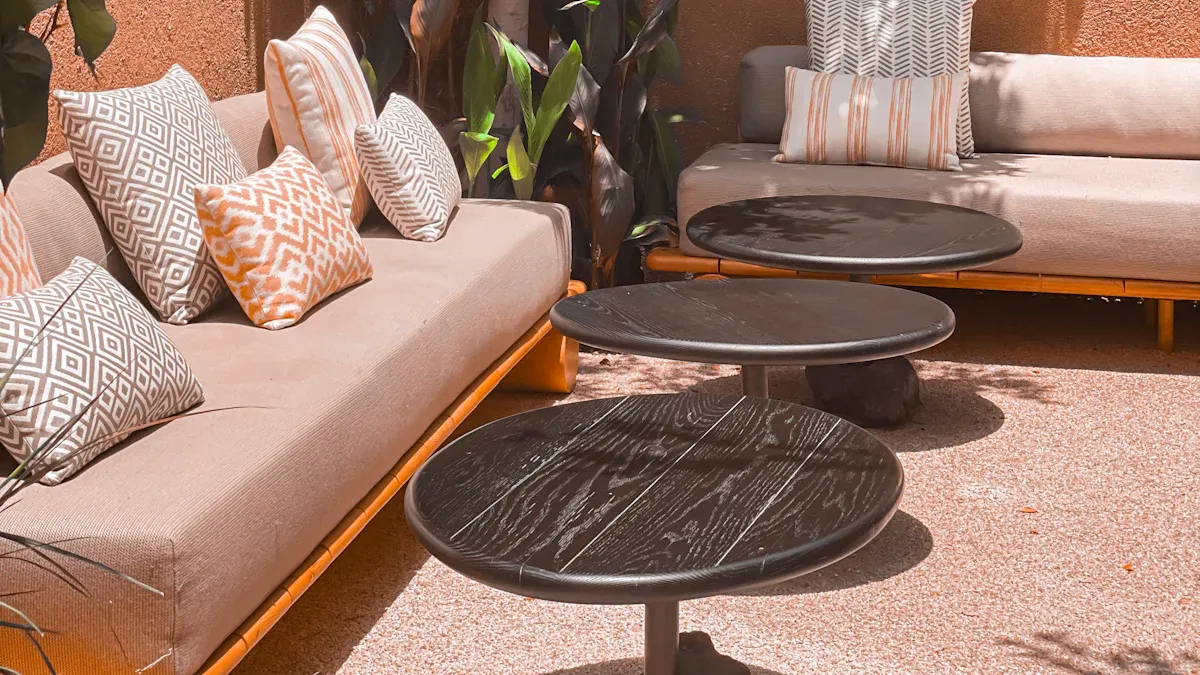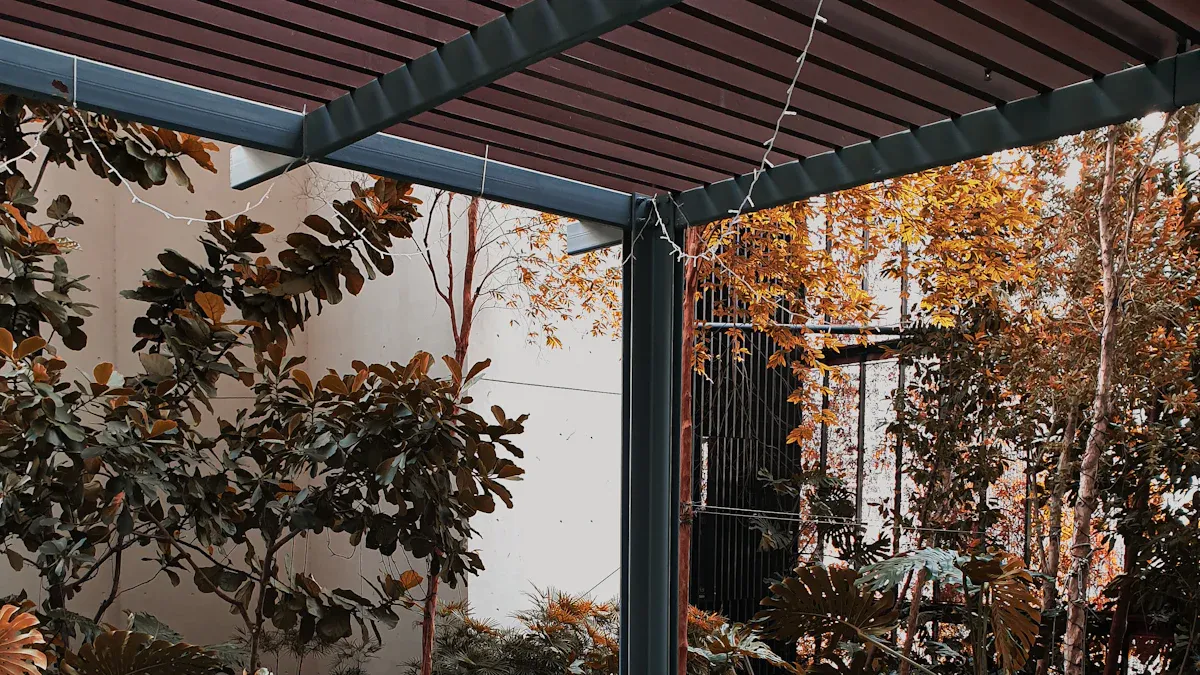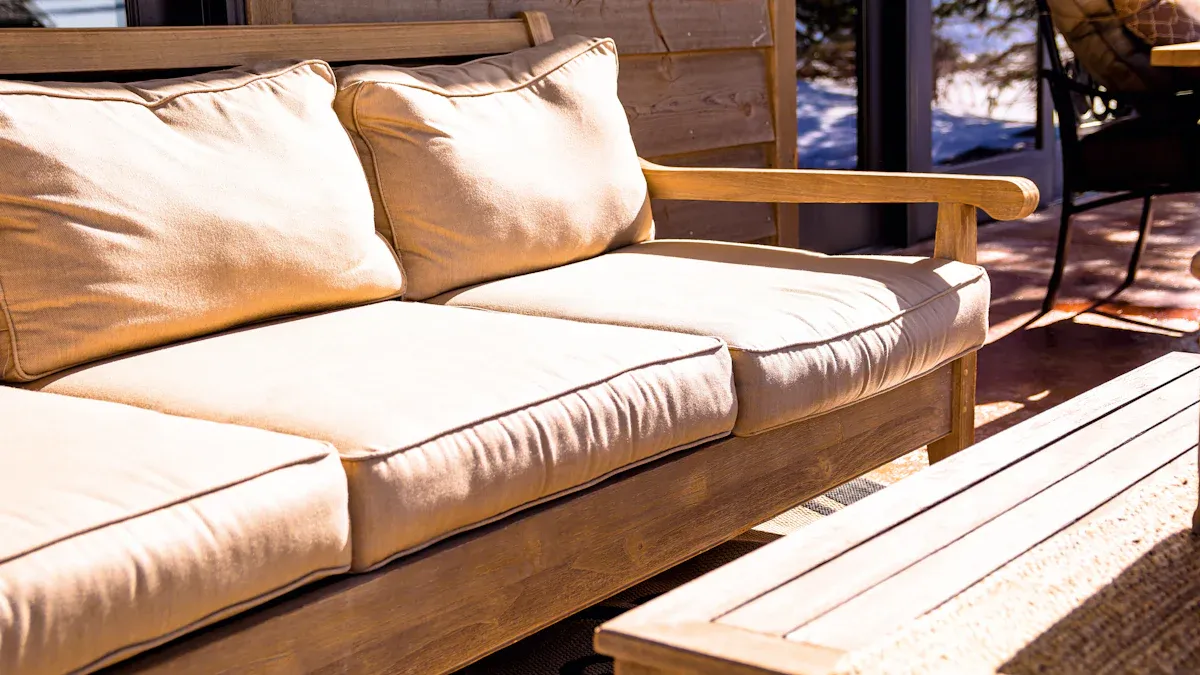
The demand for outdoor furniture prioritizing comfort and functionality continues to rise. A 2021 survey revealed that 58% of Americans plan to upgrade their outdoor spaces, while the market for ergonomic designs, including the garden sofa, is projected to grow at a 5.50% CAGR, reaching $81.44 billion by 2032. This shift reflects a desire for healthier, stylish outdoor living.
Key Takeaways
- Ergonomic garden sofas make outdoor seating comfy with back support and soft cushions, helping you sit better and relax more.
- Modular styles let you change seating setups, fitting both tiny patios and big yards.
- Buying good ergonomic garden sofas means they last long and stay eco-friendly, giving you great value.
The Rise of Ergonomics in Outdoor Design
Prioritizing health and well-being in outdoor spaces
Modern outdoor spaces are evolving into sanctuaries for health and relaxation. Research highlights the benefits of spending time in nature, with one study showing that individuals who spend at least 120 minutes weekly in natural environments report better health and well-being. Additionally, exposure to greenspaces has been linked to reduced risks of cardiovascular disease, obesity, and mental distress. These findings emphasize the importance of designing outdoor furniture that promotes physical and mental wellness. Ergonomic garden sofas, with their supportive features and natural aesthetics, align perfectly with this trend, transforming outdoor areas into restorative retreats.
The increasing focus on comfort in outdoor furniture
Comfort has become a top priority for consumers when selecting outdoor furniture. Surveys reveal that people seek pieces that enhance relaxation and create inviting spaces for social gatherings. The demand for ergonomic designs has surged, as they provide the same level of comfort as indoor furniture. Features like high-density foam cushions, breathable fabrics, and adjustable components ensure that outdoor seating, such as the garden sofa, meets these expectations. This shift reflects a growing desire for outdoor furniture that combines functionality with luxury.
How ergonomic design enhances outdoor relaxation
Ergonomic furniture is designed to support the body’s natural posture, reducing strain and enhancing relaxation. Sofas with contoured backrests, lumbar support, and deep cushions allow users to unwind comfortably for extended periods. By incorporating weather-resistant materials and modular designs, ergonomic garden sofas also offer durability and flexibility, making them ideal for various outdoor settings. These features not only improve physical well-being but also elevate the overall outdoor experience.
Key Features of an Ergonomic Garden Sofa

Adjustable components for personalized comfort
Ergonomic garden sofas often feature adjustable components that cater to individual preferences. These include reclining backrests, movable armrests, and modular sections that allow users to customize their seating arrangements. Such flexibility ensures that the sofa adapts to various activities, whether lounging, reading, or hosting guests. Modular designs, highlighted in industry analyses, also provide the versatility to reconfigure outdoor spaces, making them ideal for both small patios and expansive gardens. This adaptability enhances the user experience, offering a tailored approach to outdoor relaxation.
Deep cushions and lumbar support for posture improvement
Deep cushions and built-in lumbar support are essential for maintaining proper posture while seated. Ergonomic garden sofas incorporate high-density foam cushions that contour to the body, reducing pressure points and promoting spinal alignment. These features not only enhance comfort but also contribute to long-term physical well-being. Studies on ergonomic furniture emphasize the importance of lumbar support in preventing back pain, making these sofas a practical choice for health-conscious consumers. By prioritizing posture improvement, these designs elevate outdoor relaxation to a new level.
Durable and weather-resistant materials
Durability is a cornerstone of ergonomic garden sofas, ensuring they withstand various weather conditions. Materials like Sunbrella fabric resist fading and water, while quick-dry foam prevents mold and maintains comfort. High-quality materials such as teak, HDPE, and aluminum offer excellent weather resistance and longevity. For example, teak naturally repels moisture and pests, while HDPE, made from recycled plastics, withstands wear and tear. Protective finishes and advanced joinery techniques further enhance durability, ensuring these sofas remain functional and stylish for years.
| Material | Durability | Weather Resistance | Notes |
|---|---|---|---|
| Teak | High | Excellent | Naturally repels moisture and pests, low maintenance. |
| HDPE | High | Excellent | Made from recycled plastics, withstands weather wear. |
| Aluminum | High | Excellent | Lightweight, corrosion-resistant, low maintenance. |
Stylish designs that balance form and function
Ergonomic garden sofas seamlessly blend aesthetics with functionality. Their sleek, modern designs complement various outdoor settings, from minimalist patios to lush gardens. Many models incorporate eco-friendly materials, aligning with sustainability trends. Some even feature smart technologies like solar panels and USB charging ports, catering to tech-savvy consumers. Award-winning designs, such as those inspired by biophilic principles, demonstrate how these sofas enhance both visual appeal and user experience. By balancing form and function, they transform outdoor spaces into elegant and practical retreats.
How Ergonomic Garden Sofas Align with 2025 Trends

Sustainability through eco-friendly materials
Eco-conscious consumers increasingly demand furniture made from sustainable materials. Ergonomic garden sofas meet this need by incorporating options like reclaimed wood, bamboo, and recycled metals. Reclaimed wood reduces deforestation and minimizes waste, while bamboo offers a fast-growing, pesticide-free alternative with natural resistance to moisture. Recycled metals conserve resources and require less energy during production, making them both durable and environmentally friendly. Low VOC finishes further enhance sustainability by improving air quality and reducing harmful emissions. These materials not only support environmental preservation but also align with the growing trend of sustainable outdoor living.
Modularity for flexible outdoor arrangements
Modular designs have become a cornerstone of modern outdoor furniture. Ergonomic garden sofas with modular components allow users to customize their seating arrangements to suit various activities and spaces. Urban dwellers with limited outdoor areas benefit from this flexibility, as modular pieces can be rearranged to maximize functionality. This trend reflects a shift toward multifunctional furniture that adapts to changing needs, making it ideal for hosting gatherings or creating intimate lounging spaces.
Biophilic design and the connection to nature
Biophilic design principles enhance the connection between outdoor spaces and nature. Features like natural materials, earthy tones, and greenery-inspired aesthetics create a calming environment. Studies show that exposure to nature reduces stress, boosts creativity, and improves cognitive function. Incorporating ergonomic garden sofas into biophilic designs fosters relaxation and well-being, transforming outdoor areas into restorative retreats.
Minimalist aesthetics with a focus on comfort
Minimalist design emphasizes simplicity and functionality, making it a perfect match for ergonomic garden sofas. These sofas combine clean lines with plush cushions and breathable fabrics, ensuring both style and comfort. The trend of merging indoor and outdoor spaces has driven demand for furniture that mirrors indoor standards, creating cohesive and inviting environments. By prioritizing comfort and elegance, minimalist designs encourage extended use of outdoor spaces, promoting a healthier lifestyle.
Benefits of Choosing an Ergonomic Garden Sofa
Enhanced physical well-being and posture support
Ergonomic garden sofas are designed to prioritize health by supporting the body’s natural posture. Features like contoured backrests, lumbar support, and deep cushions help reduce strain on the spine and joints. This design minimizes discomfort during extended use, making outdoor relaxation more enjoyable. Studies on ergonomic furniture highlight its role in preventing back pain and improving overall physical well-being. By incorporating these health-focused elements, ergonomic garden sofas transform outdoor spaces into havens of comfort and wellness.
Versatility for various outdoor settings
The modularity of ergonomic garden sofas makes them highly adaptable to different outdoor environments. Whether placed on a compact balcony or a sprawling backyard, these sofas can be reconfigured to suit the available space. Their multifunctional design allows for seamless transitions between lounging, dining, and socializing. For example, modular components can be rearranged to create intimate seating arrangements or larger setups for entertaining guests. This versatility ensures that the garden sofa remains a practical choice for diverse outdoor needs.
Timeless appeal for long-lasting style
Ergonomic garden sofas combine functionality with timeless design, ensuring they remain stylish for years. Their sleek lines and neutral tones complement various outdoor aesthetics, from modern patios to rustic gardens. Market trends emphasize the importance of comfort and sustainability, both of which are integral to these sofas.
| Trend Aspect | Description |
|---|---|
| Ergonomics | Ensures comfort and support, fitting natural body curves for relaxation. |
| Sustainability | Reflects consumer preference for eco-friendly materials and designs. |
| Timeless Design | Offers enduring style that transcends fleeting trends. |
By focusing on these aspects, ergonomic garden sofas provide a blend of elegance and practicality that appeals to a wide audience.
Long-term durability and value for investment
Investing in an ergonomic garden sofa ensures long-term value due to its durability and quality materials. Treated teak, stainless steel, and weather-resistant fabrics withstand harsh outdoor conditions, reducing the need for frequent replacements. While the initial cost may be higher, the longevity of these sofas leads to significant savings over time. Additionally, many designs incorporate sustainable practices, such as modular components that can be replaced or recycled. This approach aligns with the growing demand for environmentally conscious products, further enhancing their value.
Tip: Choosing a high-quality ergonomic garden sofa is not just a purchase; it’s an investment in comfort, style, and sustainability.
Ergonomic garden sofas represent the pinnacle of outdoor comfort and functionality for 2025. Their innovative features, such as deep cushions and adjustable components, cater to modern lifestyles. Consumers increasingly value designs that prioritize health, sustainability, and versatility. With trends like modularity and smart technologies shaping outdoor furniture, these sofas redefine relaxation and style.
- Ergonomic designs enhance comfort and promote longer outdoor use.
- Features like solar panels and USB ports meet eco-friendly and multifunctional demands.
- Post-pandemic trends emphasize health-conscious, adaptable furniture.
Investing in a garden sofa transforms outdoor spaces into serene retreats, blending luxury with practicality.
FAQ
What makes ergonomic garden sofas different from regular outdoor furniture?
Ergonomic garden sofas prioritize health and comfort with features like lumbar support, deep cushions, and adjustable components. These designs enhance posture and relaxation, unlike standard outdoor seating.
Are ergonomic garden sofas suitable for small outdoor spaces?
Yes, modular designs make them ideal for compact areas. Users can reconfigure sections to maximize functionality, ensuring ergonomic comfort even in limited spaces.
How do ergonomic garden sofas contribute to sustainability?
Manufacturers use eco-friendly materials like recycled metals, reclaimed wood, and low VOC finishes. These choices reduce environmental impact while maintaining durability and style.
Tip: Look for certifications like FSC or GREENGUARD to ensure sustainable practices in your ergonomic sofa purchase.
Post time: Mar-27-2025




